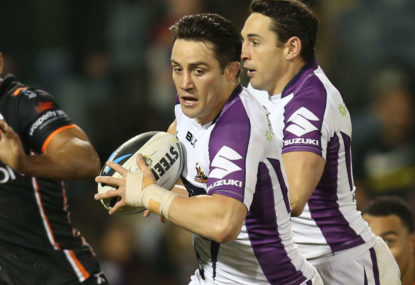LISTEN: 'Bit of carry on' - Harry Grant amusingly downplays Munster's 'stroin' injury
Harry Grant clearly isn't too concerned for his Storm and Maroons teammate!

In the aftermath of Melbourne Storm’s victory over the Sydney Roosters, a range of implausible excuses have been made by Roosters and non-Melbourne supporters. Unfortunately Trent Robinson decided to join in.
In the post-match interview, Robinson charged that Melbourne were able to win due to the officials’ inability to properly adjudicate the ruck.
This is a common refrain when teams lose to Melbourne, the charge being that they are either the only the club in the competition that wrestle, or they are the only club that can get away with it.
Both statements are demonstrably untrue. Melbourne won last night’s game in the ruck, both in defence and in attack. It was the Roosters’ ineffectiveness at wrestling, despite their best attempts, that lost them the game.
I think a lot of fan’s gripes with wrestling comes from their lack of understanding of how all teams are coached to win the ruck, in both defence and attack.
Every club is coached to wrestle. Thankfully due to rule changes and proper adjudicating, wrestling no longer involves applying pressure to the neck or shoulder of the ball player. Wrestling is simply the tiny battles that take place in order to win the ruck.
Defenders are taught to wrestle the ball carrier into the most advantageous position for the defending team, and conversely attackers are taught to wrestle themselves into optimal ball-playing position.
Defensive control
There are three elements to controlling the ruck defensively: hitting, sticking and wrestling. Melbourne were hitting (hard), sticking and wrestling.
For decades, rugby league players, even at a junior level, have been instructed to get the ball-carrier onto their back. Modern-day wrestling is nothing more than this, albeit with a great deal more emphasis on the one per cent actions that influence the outcome of the wrestle.
The position of the feet, getting one arm inside one of the ball carrier’s arm with the other wrapped around the opposite shoulder, repositioning the ball carrier to use their momentum to turn them onto their back, timing the fall to maximise time spent holding down the ball carrier.
This isn’t gamesmanship. It’s what’s been taught for many years. Now it’s simply more scientific, and the Melbourne Storm, as is their procedural culture, are better at it than other club because they put more time into the those tiny one per cent moments.
It’s ironic that the only example I can find online of last night’s game leads up to a Roosters try, but keep in mind the Storm replicated this effort over the entire course of the game.
Watch this defensive set in the lead-up to Blake Ferguson’s try. In particular the second tackle. Melbourne’s Asofa-Solomona hits (he makes good chest contact), he sticks (gets his arms in the right position), and he wrestles (keeps his head close and uses Sio Siua Taukeiaho’s momentum to turn him on his back). He then uses his weight to minimise Taukeiaho’s ability to move on the ground.
It’s important to note that in this set the Roosters only make 15 metres in four tackles. Ferguson will go onto score but it is more due to his own brilliant ability than the Roosters winning the ruck in attack. It had until then been an effective defensive set from the Storm.
Attacking control
Now compare that with the ability of Melbourne’s ball-carriers to find their front and win the ruck. A great example is the build up to Marika Koroibete’s try early in the first half.
Tackle 1: Despite landing on his back, Matt Duffie is quick to roll onto his front and brings his knees in, making it impossible for him to lose this position. Storm win the quick play the ball.
Tackle 2: Koroibete uses this momentum to hit a retreating defensive live and despite being turned backwards, finds his front upon hitting the ground.
Tackle 3: Jesse Bromwich makes contact and immediately finds his front, locking his body into an immovable position.
Tackle 4: Despite Ryan Hinchcliffe’s attempt to roll on his front, Boyd Cordner successfully wrestles him to his back (with good technique as well – look at his arm wrapped around Hinchcliffe’s shoulder). That’s right Roosters fans, the Roosters wrestle just like all the other clubs!
Koroibete would go on to score off this play the ball, but only after the Storm won this set by winning the rucks in attack.
The lead up to Tim Glasby’s try is also a good example of the Roosters’ ineffective wrestle and inability to control the ruck, except for Asofa-Solomona’s first hit-up, where Nathan Friend effectively hits, sticks and wins the wrestle.
It’s worth keeping all of this in mind when watching the Storm and you will soon realise why a player like Bromwich is the best forward in the game. His footwork at the line causes defenders to shift their weight away from him. He then uses the momentary lapse in judgement to hit, drop and find his front, winning the play the ball.
Out of the backs, Greg Inglis is probably the best at this and is also a product of Melbourne’s coaching.
The modern game of rugby league is becoming more scientific in studying and honing these tiny battles, and I find the game all the more fascinating to watch because of it. Every tackle is a calculation of momentum and technique. Every hit-up is a war of pre-emption and core strength.
These tiny moments are what makes each try a hard-earned miracle and rugby league the greatest game of all.